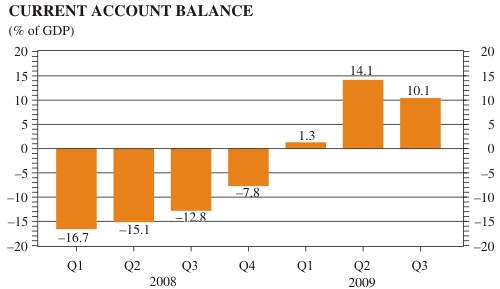Latvia's Balance of Payments in the Third Quarter of 2009
In the third quarter, the surplus in the current account of Latvia's balance of payments (10.1% of GDP or 327.9 million lats) contracted quarter-on-quarter due to a decline in losses of direct investment companies and current transfers received. With export growth exceeding that of imports, the goods and services balance was positive for the second consecutive quarter, standing at 0.3% of GDP or 11.2 million lats.

Foreign trade turnover of goods and services expanded, reaching 86.2% of GDP (78.2% in the previous quarter), mostly on account of the growing trade of goods and exports of travel services. The largest inflows in the capital and financial account resulted from the government borrowing and the related increase in the Bank of Latvia reserve assets as well as new foreign direct investment inflows in the equity capital of Latvian companies and other capital in the amount of 304.3 million lats and 62.9 million lats respectively, offsetting the losses of direct investment companies.
In the third quarter, net external debt shrank by 0.5 billion lats in nominal terms, but due to the downslide in GDP the ratio of net external debt to GDP posted a minimal drop, to 56.4%. Gross external debt (excluding foreign assets) to GDP grew to 145.8%.
Assessment of Latvia's balance of payments
In the third quarter, data of Latvia's balance of payments point to a gradually restoring confidence in the Latvian economy and orientation towards export-driven growth. As the external demand and competitiveness improved, exports of agricultural and food products as well as textiles posted a further quarter-on-quarter increase. Exports of cyclically sensitive commodity groups (wood, metals, machinery and transport vehicles) also moved up. Export goods which are less dependent on the business cycle fluctuations - food products and products of the chemical industry - make up a larger share in exports to Lithuania and Estonia while that of wood and metals is smaller. Imports grew on account of higher imports of export-related intermediate goods. Financing outflows from the private sector moderated. That might suggest restoration of confidence in macroeconomic stability.
Exports and imports of goods and services are expected to be close to balance in 2009 while the losses of direct investment companies will have the most pronounced impact on the balance of the current account. In the near future, major risks to exports are likely to be related to transportation services as new trade routes, reducing the use of transit via Latvia, are being developed, and the competition in freight transportation in the region increases. With the competitiveness growing and high production capacity persisting, the increase in goods exports due to the recovery of the external demand could be faster than projected unless the expanding imports of trade partners are hindered by economic stagnation or protectionism. The approval of the state budget for 2010 will improve investors' confidence in Latvia; nevertheless, the uncertainty surrounding the fiscal, inter alia tax policy, continues to have a negative effect on the investment inflows from abroad.
Beginning with the information for the fourth quarter of 2009, Latvia's balance of payments, international investment position, and external debt data will be published on the 65th day after the end of the reporting quarter, i.e. 20 days earlier than before.
Textual error
«… …»





